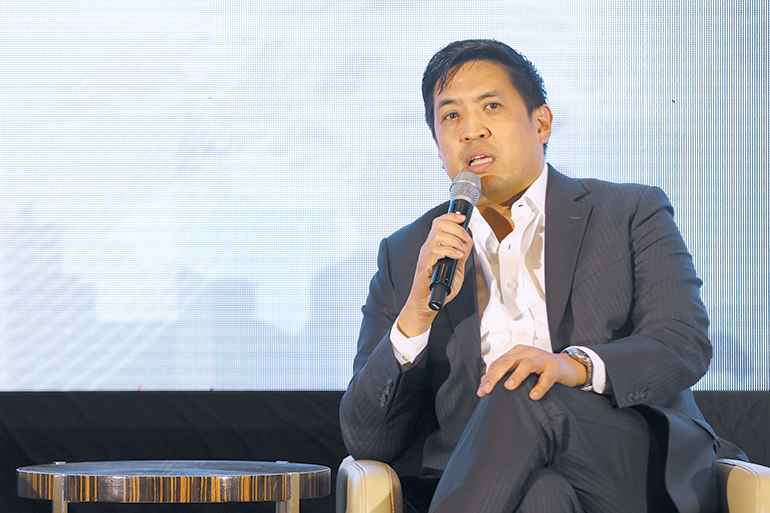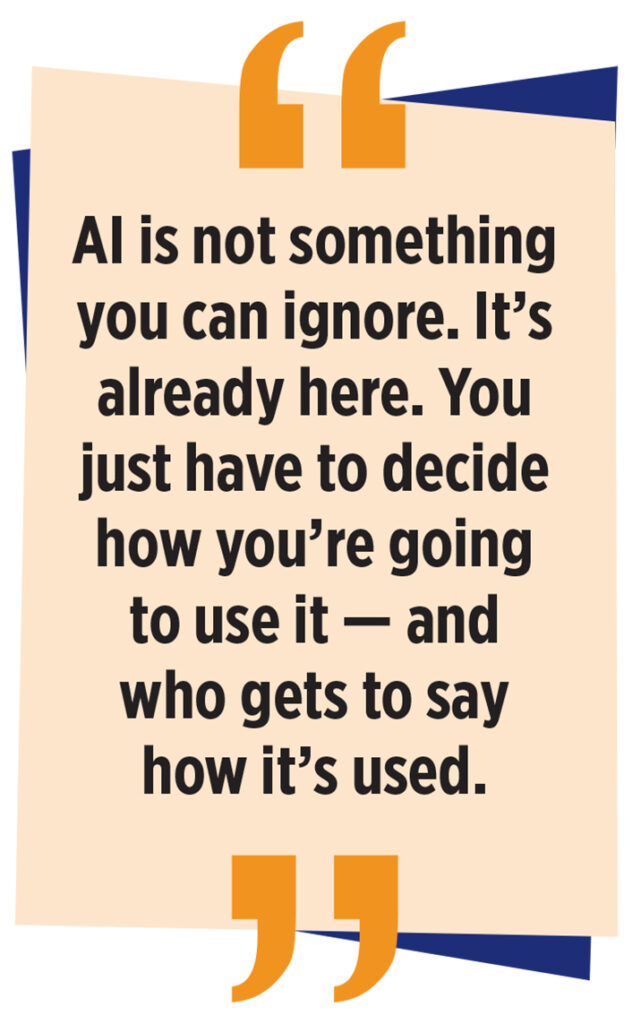Exploring artificial intelligence’s potential in businesses

By Mhicole A. Moral, Special Features and Content Writer
The Philippines is on track to grow its artificial intelligence (AI) industry to a projected $3.5 billion by 2030. With a compound annual growth rate estimated at 28.5%, the country’s AI market is expected to rise from its current estimated value of $772 million. The potential growth could bring in an additional $92 billion to the nation’s gross domestic product (GDP), marking a possible 12% increase over the same period.
Experts believe the rapid expansion of AI technology could drive broad economic gains, especially if industries begin adopting these tools more widely and with clear objectives.
During the BusinessWorld Economic Forum 2025 held on May 22, the fireside chat titled “Navigating AI Adoption in the Philippines” featured insights from key players in the industry. Derick Ohmar Adil, senior director of AI Data Governance at Globe Telecom; and Patricio S. Pineda III, senior vice-president and Enterprise Business head at PLDT Enterprises, addressed the current state of AI in the country and what needs to happen for it to develop further.
According to both executives, the Philippines is still at the beginning of its journey with artificial intelligence. While there is high interest in the technology, there is a lack of understanding about how to implement it effectively within existing systems.
Mr. Adil explained that many businesses show enthusiasm about AI but are unsure about where to begin, which slowed actual adoption among key sectors.
“Most [businesses] are excited about what is being said about artificial intelligence,” Mr. Adil added. “But they do not know where to start. It is the common thing I hear.”
Such disconnect is not limited to small businesses, as large corporations are still in the early stages of understanding how AI can fit into their structures. That is why real-world application of AI is still at a low level.
The Globe executive described the current situation as “the starting line,” with significant room for growth and experimentation. He believes AI offers measurable benefits, and the challenge now is to convince more businesses to begin experimenting with it.
Meanwhile, Mr. Pineda shared that AI has become more accessible, and many people use it every day without realizing it. Improved processing speeds, better machine learning models, and the growing availability of user-friendly tools are making it easier for companies to experiment with AI. Speech-to-text and text-to-speech features, for example, are now being used in customer service, transcription, and accessibility services.
“Any time you click on your mobile, that’s AI. Any time you type something into Google and you get suggestions, that’s AI,” he said.
Mr. Pineda also explained that people often benefit from AI through small features in mobile applications or customer service chatbots, even if they are not directly aware of it.
Still, both speakers pointed out that adopting AI is not as simple as downloading a new software. Companies need the right infrastructure and employee training. Without those, AI cannot function as a useful business tool.
Embracing AI in key industries
AI adoption in the country is currently concentrated in four key areas: customer service, logistics, data processing, and creative services, according to the experts. Businesses adopting AI technologies are now already gaining advantages, including improved operational efficiency, faster decision-making, and cost reduction.
“With AI, you can now do things with your own devices that used to take teams of people,” said Mr. Pineda. “That’s something both private companies and public services can use to get better results.”
In contrast, sectors and companies that delay AI adoption may fall behind, potentially worsening existing economic disparities. Many local companies, especially small and medium-sized enterprises, remain hesitant due to uncertainty about where to begin.
“In the business sector, there are many areas where if you are not doing anything about AI right now, you are already on the back side of the curve,” Mr. Adil explained.
While advanced technologies are accessible, the underlying infrastructure required to support them is still inconsistent. In rural areas, internet access remains unreliable. Electricity issues also persist. These factors limit the ability of industries such as agriculture and regional healthcare to take advantage of emerging technologies, despite the availability of advanced tools in global markets.
Another major challenge identified by both experts is the absence of a structured approach toward AI integration. Most Philippine companies still do not have a road map for how to apply AI in their operations.
 In addition, “AI hallucination,” where systems generate false or misleading information that appears legitimate, can harm individuals or organizations if not addressed through proper training and checks.
In addition, “AI hallucination,” where systems generate false or misleading information that appears legitimate, can harm individuals or organizations if not addressed through proper training and checks.
Mr. Pineda suggested rethinking job definitions entirely. It is no longer enough to insert AI tools into traditional roles. Companies need to reshape workflows and expectations, making room for oversight, critical review, and collaboration between human workers and AI systems.
Both experts also shared the existing shortage of professionals with the right skills to work with AI systems. This leads to the perception that AI might replace jobs, rather than improve how tasks are performed. Instead, AI should be seen as a tool to assist human workers and improve productivity.
They suggest that public and private institutions must invest in educational programs that teach employees how to work with AI technologies, not fear them. Without a clear and unified effort to promote AI literacy and capability, the country risks falling further behind more digitally mature economies.
Currently, AI training is concentrated in a few institutions, mainly universities and technical schools with strong information technology departments. Some companies in the business process outsourcing and IT sectors offer in-house upskilling programs, but these efforts are not enough to cover the broader workforce.
Mr. Adil explained AI adoption will only succeed if the country closes its digital gaps. These conditions put large portions of the population at risk of being left behind. A larger investment in education is needed — not only to train future AI developers but also to educate workers, policy makers, and the general public.
Good governance in AI
AI adoption is directly connected to long-term national competitiveness, particularly if both the private and public sectors begin using the technology more systematically. However, many efforts may never reach their full potential without a unified support system.
“AI governance is so important,” Mr. Pineda said. “It is about the system we use. You have to have the right mix of voices — the government, the people, the market.”
Governance, in this context, refers to the systems of rules, standards and practices that regulate AI development and usage. It includes data privacy laws, ethical guidelines, system accountability and safeguards against algorithmic bias. Without strong governance, companies operate in silos, which can create inconsistent practices and open doors to potential misuse.
Experts said no central policy guides the country’s approach to AI. The lack of regulation leaves private companies in a position where they must create their own rules, which do not always align with one another or with global standards.
In fact, the National Government has yet to enact a comprehensive bill on AI. Although the Department of Information and Communications Technology (DICT) has signaled plans for an AI road map, no specific timeline or structure has been provided. In the absence of clear rules, experts fear potential misuse of technology.
“AI is not something you can ignore,” Mr. Pineda said. “It’s already here. You just have to decide how you’re going to use it — and who gets to say how it’s used.”
In the private sector, decisions about AI implementation occur within limited circles, including only corporate boardrooms and select policy-making bodies. Such exclusivity creates a gap between those creating AI tools and the communities affected by them.
Expanding the conversation to include a wider range of voices, such as educators, workers, and local government units, is necessary. Doing so helps prevent policies that favor only specific sectors or regions and ensures AI development benefits broader society.
“We should make sure that we are making a policy for a national solution,” said Mr. Adil. “Governance is there to act as far as we could fly. We need to be able to make sure that we get support to be able to support the business of the client.”
He also explained that national support would offer companies the direction they need and reassure consumers and investors. Confidence in how data is collected and used is essential. Without it, people are less likely to trust AI-powered platforms, regardless of how useful they might be.
Both executives explained that AI adoption becomes easier when the public understands the rules and trusts how they are enforced. Policy is particularly important for sectors such as healthcare, education, and public safety, where the margin for error is smaller and public expectations are higher.
They also urged government institutions to adopt AI within their own operations to show that the technology is practical and effective. If the government demonstrates responsible AI use, it becomes easier to convince the public and private sectors to follow. The effort also sends signal to international investors that the country is ready to participate in global tech markets under stable and transparent guidelines.
The current interest in AI may be the first step, but real progress depends on execution. Unlocking the country’s potential in AI will require action from both the government and the private sector, the experts concluded.



